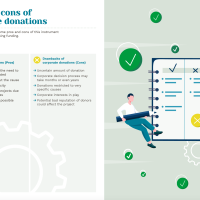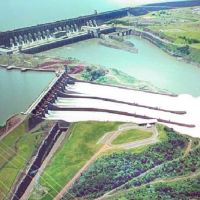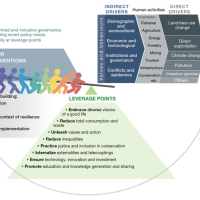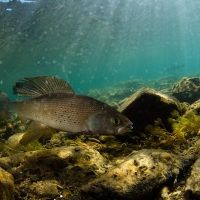The Northern Basins: modelling the Vansjø-Hobøl catchment

Lake Vansjø. Image: Raoul-Marie Couture
Last week we introduced MARS’s research on multiple stresses in the Vansjø-Hobøl catchment in Southern Norway. This week, we discuss the computer models that the Work Package 4 team will use to understand how rivers and lakes in the catchment respond to stress – largely nutrient pollution – both now and in the future.
Environmental models
Two computer models are being used by the MARS team to understand and predict how water quality in the catchment might respond to future environmental change, at both the catchment and lake scale. The data to run the MARS models in the Vansjø-Hobøl catchment comes from two monitoring programs: Bioforsk (river data) and NIVA (lake data).
Computer models are used to simulate the impact of different scenarios – for example, increased rainfall, air temperatures or fertiliser pollution – on freshwater ecosystems. Models are designed using observations taken in the field and laboratory on how different aspects of the environment respond to change and stress, and then use a complex set of calculations to simulate environments under a variety of different scenarios. Models are extremely important in providing guidance to environmental managers and policy makers in responding to environmental issues and predicting what impacts management is likely to have.
Catchment Model
The MARS team will use the INCA (‘Integrated Catchment’) model to understand the sources, distribution and impact of phosphorous through the Vansjø-Hobøl catchment. The INCA model tracks the flow and quality of water through the catchment, showing the dynamic, day-to-day fluctuations of these parameters in response to human-caused stresses such as agricultural pollution or sewage discharges. INCA can also be used to model the impact of long-term environmental and land-use changes – such as climate change and afforestation – on freshwaters in a catchment. It can model the dilution, natural decay and transformation (e.g. uptake by vegetation) of different chemicals – in MARS’s case for phosphorous, nitrogen and carbon – in water flows.
INCA then produces a range of visual representations of environmental responses to stress over time. The INCA model was developed by researchers at the University of Reading, the Swedish Agricultural University, the Finnish Environmental Institute and NIVA as part of several EU funded projects including Eurolimpacs, and others funded by UK government bodies such as NERC LOCAR.
As Paul Whitehead and colleagues demonstrate in a 2013 paper, INCA can be used to assess the cost-effectiveness of different schemes to manage and mitigate phosphorous pollution. Their INCA analysis of the River Thames in Southern England suggested that the most cost-effective management solution would be to encourage reductions in agricultural fertiliser use, alongside implementing improvements to sewage treatment processes.

River Hobøl Image: Reiseliv Indre Østfold
Lake Model
The dynamics and functioning of lakes in the Vansjø-Hobøl catchment will be modelled using the MyLake model developed by NIVA in Norway. As this 2007 paper by Tuomo Saloranta and Tom Andersen describes, MyLake is a ‘multi-year lake simulation model‘ that simulates the daily vertical distribution of lake water temperature, the evolution of seasonal lake ice and snow cover, sediment-water interactions and phosphorus-phytoplankton dynamics. These variables can be modelled through time by using known environmental factors such as the shape and depth of the lake (its ‘morphometry’), atmospheric conditions such as temperature, pressure and wind, and the amount of sediment and nutrients already in the lake (called ‘loading’ by ecologists).
As for the INCA catchment model, MARS’s focus is on phosphorous dynamics in the lakes and on the biological and physical processes controlling algal growth which can lead to harmful blooms. The MyLake model is particularly useful to policy makers as it allows for analyses to be made of the uncertainties in its predictions, and of the sensitivities of the model to the different input parameters.
Linking INCA and MyLake in MARS
In this 2014 paper, Raoul-Marie Couture and colleagues describe how the two models can be linked. Their key observation is that because the models run their analysis on a day-to-day basis using the same factors – phosphorus concentration and water quantity – they can be used in tandem to analyse both the lake and the catchment under the same scenarios, allowing for more thorough predictions of ecosystem responses to stress. Their paper’s conclusion is that both land use and climate change can increase the frequency of algal blooms, but that suitable management can overcome any detrimental effect of climate change if appropriately implemented.
Raoul explains how his collaborative MARS team will use the insights from this research to link the two models, “MARS is a motivating challenge because we have to use our most recent models for water quality in a totally new way. We will have to predict the response of biological indicators of water quality, consider the communication of results and uncertainty to stakeholders, and also say something on how the economic value of ecosystem services may change in response to environmental stresses. This forces me to reach out to biologists, social scientists and economists early on in the project.”
Raoul emphasised the novel, cross-disciplinary nature of this work. “This idea of linking models is not new, in fact most complex models are made of connected modules. However in MARS we will link models that would not normally be used together as one: including hydrological models, biological response models, and economic valuation models.”
Raoul added, “MARS researchers in Finland will use the exact same models (INCA and MyLake), but they have compiled them differently, and this is described in a 2014 paper by Maria Holmberg and colleagues. Their focus is more on carbon than phosphorus. In Estonia, they will also use INCA, but they have their own lake model adapted to the lake of interest, as described in a 2014 paper by Fabien Cremona and colleagues. These are three very recent developments in catchment-lake modelling.”














